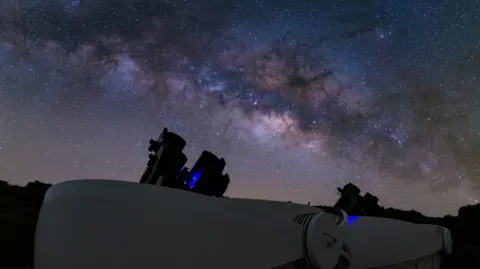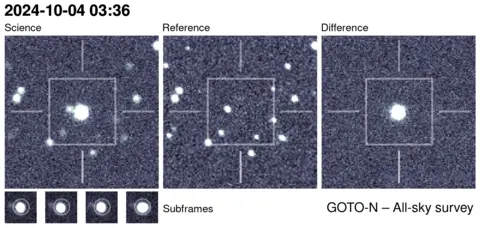Citizen scientists help find exploding star
 GOTO/T. Killestein
GOTO/T. KillesteinAstronomers at the University of Warwick have found a new exploding star in the sky but they said they would not have been able to do it without a team of amateur citizen scientists alerting them to what is going on.
The sky is such a vast area, the truth is that the world's telescopes are not guaranteed to be looking at the right part of it when something interesting happens.
Even with equipment that can capture all the stars in the northern or southern hemisphere at once, there is still so much data it is possible to miss a big event - especially if it is over quickly.
Enter the Kilonova Seekers.
That is a website that asks the public to play "spot the difference" with images of a section of the sky taken over successive nights.
The aim is to find anything unusual and alert astronomers who can then spring into action for a closer look.
On Tuesday, the project's first big success is published in the Astronomy and Astrophysics journal - an exploding star that was spotted as it increased in brightness by 2,500 times over a few days.
Astronomers were able to study the star very early on in its evolution and it has been identified as a "cataclysmic variable star", named GOTO0650
 GOTO/T. Killestein
GOTO/T. KillesteinOne of the scientists at Warwick and co-lead of Kilonova Seekers, Dr Tom Killerstein, told me: "Remarkably, public volunteers identified this star as an object of interest within three-and-a-half hours of the image being taken by the telescopes.
"This discovery could have been missed, among many other objects, without their efforts."
About eight people flagged this event as interesting and that was the trigger for the professionals to give this star their undivided attention, capturing the very early stages of an otherwise hard to spot cosmic event.
GOTO0650 is a binary star system with a disc of material around it and that material seems to have ignited, causing this flash.
Both the stars are still there so there is the potential for it to happen again.
A big first
Dr Killerstein explained to me "we know this already happened in the 1930s" but it was not spotted at the time.
Rather, we have photographic plates of the whole sky from then, which were more recently digitised and analysed to reveal this event, years after the pictures were taken.
Thanks to the Kilonova project today, these events are now identified in hours rather than years.
This also means we can train the best astronomical instruments on to an event much earlier too.
Interestingly, this also indicates this particular explosion might be a regular thing and happen again in about another century.
If you are wondering why artificial intelligence (AI) is not used for this analysis, well Dr Killerstein says machine learning is a useful tool.
However, with cases which a computer might miss, a human eye and brain tends to do better as "you need to have a human in the loop".
After several smaller supernovas, this is the first big event to come out of this project which has only been running for a year.
In a nice turn of events, this explosion was so bright that about 100 amateur astronomers around the world were also able to track it and see it as well.
Follow BBC Coventry & Warwickshire on BBC Sounds, Facebook, X and Instagram.
